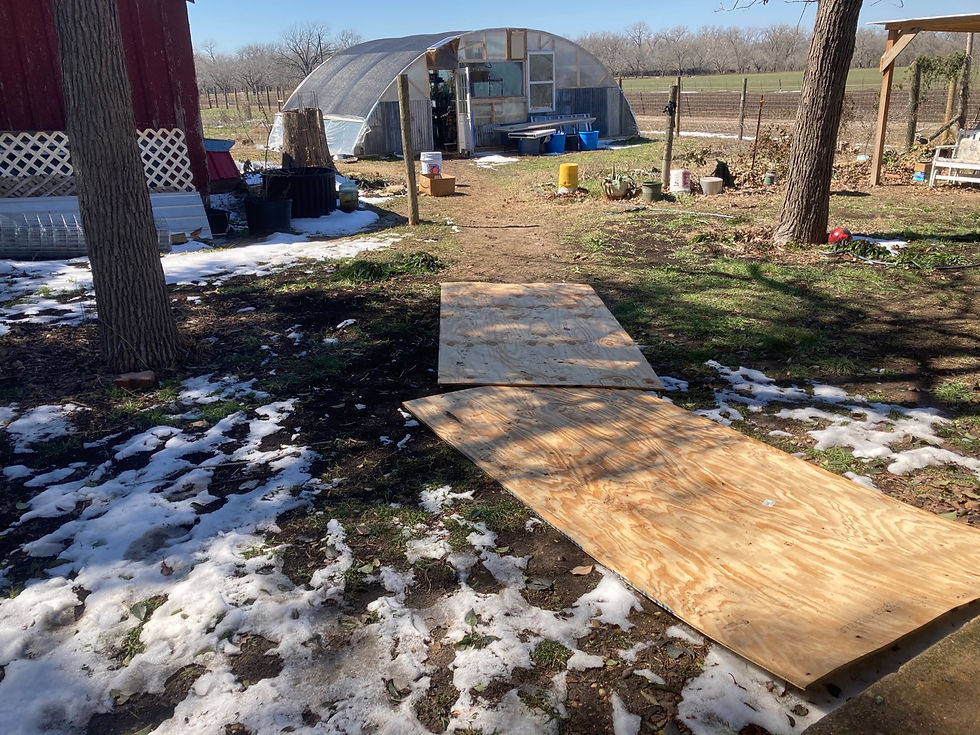After-Blizzard Garden Assessment - Part 1
- smalltownfarm

- Feb 25, 2021
- 3 min read
Updated: Aug 3, 2023
The 7 straight days of frost and snow has passed and it’s warm and sunny outside again. In fact, the greenhouse temps were hovering around 86 the other day and that’s with an 80% shade cloth and windows open. Texas is weird, y’all.



While this prolonged freezing weather was a rare event, we certainly don’t think it’ll be the last time something like this will happen. Here are some notes and observations while it’s still fresh.
Snowpocalypse Garden Prep - Lessons Learned:
🌼 Bring as many frost sensitive potted plants indoors as possible. Dig up new plant starts and plants unlikely to make it (calendula and lettuce transplant well, poppies don’t). Once frost has passed, leave them outside in the shade for a couple days before transplanting so they can transition from the extremes more slowly.


🌼Mulch and cover frost-sensitive flowers that don’t transplant well (poppies). Plastic lettuce tubs and mason jars all worked well.




🌼 Harvest all greens well before the freeze, sell extra or share with neighbors, and work on preserving them. Have multiple preservation ideas in case the power goes out for days.



🌼Trim back all but a few leaves, cover with buckets or wire cages/blankets to insulate and keep tarp from touching plants. Then cover with a tarp.




🌼There might be some frostbite on the larger leaves and tips, but those can be trimmed back and the plant will regenerate from the base.

🌼Collect as many leaves as possible for heavily mulching everything

🌼Wrap young tree trunks and frost-sensitive vines (like passionflower) with cardboard to insulate and prevent splitting.


🌱Plants that survived uncovered: plants like elderberry, rue, chives, and native herbs and wild weeds all survived uncovered. Of the winter greens we had planted this year, napa cabbage, mustard greens and kale (especially blue curled scotch and Russian red varieties) were the hardiest.




🌱Plants that survived (mulched and/or covered with tarps/glass jars/plastic bins):
We were able to protect a lot of plants this way - Rosemary, oregano, thyme, lemon balm and other mints, kale, chicory, chard, sorrel, cilantro, parsley, salad burnet, onions, garlic, Some plants (like chard, calendula, and artichoke) melted to mush on the outside but many plants regenerated from the base after time. We were able to save some of the smaller poppies and dill plants, but the larger ones were toast.





🌱Many plants we didn't cover well or at all melted to mush. We likely could have saved a lot more, but it wasn't possible to cover everything. Oh well, blank slates can be good sometimes. And that's the nature of winter gardens. You win some, you lose some. Here are some before and afters.







Not sure yet (gonna wait and give it more time):
beautyberry
artichoke
oleander
aloe
goji berry
blackberry
oleander
red spiral mallow
mexican flame vine
pride of Barbados
passionvine
esperanza
paperwhites
huisache
pecan
arizona cypress
almond verbena
flame acanthus
lantana
mexican mint marigold
curry tree
citrus
pomegranate
chocolate persimmon
loquat
hibiscus
lemongrass
galangal
turmeric
jasmine
agave
piquin
evergreen sumac






For plants where there‘s still clearly green at the base, our tactic is to wait and observe. Nature is resilient and plants want to live. And anything that doesn’t make it, that’s just food for the soil.
It‘s weird to see so much decaying plant material in a space that was vibrant and flourishing just a couple weeks ago, but we also welcome this chance to correct some of the poorly thought out planting decisions made early on. Now that we’ve had much longer to interact with this space and we have new structures like the fence and catio, the garden definitely could use some reconfiguring.
We’re also curious about what spring has in store for us. I wonder if this prolonged cold snap might be just what nature needed to keep fleas and mosquitoes under control. Will it also awaken dormant wildflower seeds in the soil seed bank that need a period of cold stratification to germinate? I guess we’ll see. 😊




